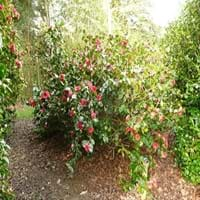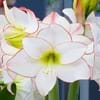Life Span
Perennial
Perennial
Type
Bulb or Corm or Tuber
Broadleaf Evergreen
Origin
Hybrid origin
China, Japan, Korea
Types
Not Available
Not Available
Number of Varieties
Not Available
Habitat
tropical environments
Dappled Shade, Shady Edge, Woodland Garden
USDA Hardiness Zone
8-11
7-9
AHS Heat Zone
Not Available
10-7
Sunset Zone
21,22
4, 5, 6, 7, 8, 9, 12, 14, 15, 16, 17, 18, 19, 20, 21, 22, 23, 24
Habit
Clump-Forming
Oval/Rounded
Flower Color
White, Red, Light Pink
Light Pink
Flower Color Modifier
Bicolor
Not Available
Fruit Color
Green, Brown
Black
Leaf Color in Spring
Green, Dark Green
Dark Green
Leaf Color in Summer
Light Green
Dark Green
Leaf Color in Fall
Several shades of Green
Dark Green
Leaf Color in Winter
Light Green
Dark Green
Leaf Shape
Long Linear
Ovate
Plant Season
Spring, Summer, Winter
Spring, Summer, Fall, Winter
Sunlight
Full Sun, Partial Sun
Partial Sun, Partial shade
Growth Rate
Medium
Medium
Type of Soil
Loam, Sand
Loam
The pH of Soil
Acidic, Neutral
Acidic, Neutral
Soil Drainage
Well drained
Average
Bloom Time
Not Available
Early Spring, Late Winter
Tolerances
Deer resistant
Not Available
Where to Plant?
Container, Ground, Pot
Ground, Pot
How to Plant?
Divison, From Rhizomes, Tubers
Cuttings, Seedlings
Plant Maintenance
Low
Medium
Watering Requirements
Average Water Needs
Average Water Needs, Do Not over Water
In Summer
Lots of watering
Drought Tolerant, Average Water
In Spring
Moderate
Moderate
In Winter
Average Water
Average Water
Soil pH
Acidic, Neutral
Acidic, Neutral
Soil Type
Loam, Sand
Loam
Soil Drainage Capacity
Well drained
Average
Sun Exposure
Full Sun, Partial Sun
Partial Sun, Partial shade
Pruning
Cut or pinch the stems, Remove damaged leaves, Remove dead branches, Remove dead leaves
Remove damaged leaves, Remove dead branches, Remove dead leaves
Fertilizers
as it is a flowering plant, use high phosphorous content fertilizer, Nitrogen, Phosphorous, Potassium, Requires high amount of nitrogen
10-10-10, 8-8-8
Pests and Diseases
Aphids, Grasshoppers, Mealybugs, Mites, Red blotch, Slugs, Snails
Black Mold, Flower Blight, Free of serious pests and diseases, Leaf Gall, Leaf spot
Plant Tolerance
Deer resistant
Not Available
Flower Petal Number
Not Available
Double
Edible Fruit
Not Available
No
Fragrant Flower
Not Available
Yes
Foliage Texture
Medium
Medium
Foliage Sheen
Glossy
Glossy
Attracts
Bees, Butterflies, Hummingbirds
Butterflies
Allergy
poisonous if ingested
no allergic reactions
Aesthetic Uses
Beautification, Bouquets, Cottage Garden, Showy Purposes
Bonsai
Beauty Benefits
Not Available
Not Available
Environmental Uses
Not Available
Air purification
Medicinal Uses
Not Available
Astringent, Cancer, Haemostatic, Salve, Tonic
Part of Plant Used
Flowers
Flowers, Leaves, Seeds
Other Uses
Used as Ornamental plant, Used for bedding in gardens
As a tea substitute, Used as a hair-dressing oil, Used for making green dye
Used As Indoor Plant
Yes
Yes
Used As Outdoor Plant
Yes
Yes
Garden Design
Container, Cutflower, Houseplant, Mixed Border, Tropical
Feature Plant, Foundation, Mixed Border, Topiary, Bonsai, Espalier
Botanical Name
HIPPEASTRUM 'Picotee'
CAMELLIA japonica 'Debutante'
Common Name
Florist Amaryllis, Hippeastrum, Picotee Hippeastrum
Camellia, Debutante Camellia, Japanese Camellia
In Hindi
HIPPEASTRUM
Japanese Camellia
In German
HIPPEASTRUM
Japanische Kamelie
In French
HIPPEASTRUM
Camellia japonais
In Spanish
Hippeastrum
Camelia japonesa
In Greek
Hippeastrum
Ιαπωνικά Camellia
In Portuguese
HIPPEASTRUM
Camellia japonês
In Polish
Hippeastrum
Japoński Camellia
In Latin
Hippeastrum
Camellia Italica
Phylum
Magnoliophyta
Magnoliophyta
Class
Magnoliopsida
Magnoliopsida
Order
Asparagales
Theales
Family
Amaryllidaceae
Theaceae
Clade
Angiosperms, Monocots
Angiosperms, Asterids, Eudicots
Tribe
Not Available
Theaeae
Subfamily
Amaryllidoideae
Theoideae
Number of Species
Not Available
Season and Care of Hippeastrum and Japanese Camellia
Season and care of Hippeastrum and Japanese Camellia is important to know. While considering everything about Hippeastrum and Japanese Camellia Care, growing season is an essential factor. Hippeastrum season is Spring, Summer and Winter and Japanese Camellia season is Spring, Summer and Winter. The type of soil for Hippeastrum is Loam, Sand and for Japanese Camellia is Loam while the PH of soil for Hippeastrum is Acidic, Neutral and for Japanese Camellia is Acidic, Neutral.
Hippeastrum and Japanese Camellia Physical Information
Hippeastrum and Japanese Camellia physical information is very important for comparison. Hippeastrum height is 38.10 cm and width 30.10 cm whereas Japanese Camellia height is 210.00 cm and width 165.00 cm. The color specification of Hippeastrum and Japanese Camellia are as follows:
Hippeastrum flower color: White, Red and Light Pink
Hippeastrum leaf color: Green and Dark Green
Japanese Camellia flower color: Light Pink
- Japanese Camellia leaf color: Dark Green
Care of Hippeastrum and Japanese Camellia
Care of Hippeastrum and Japanese Camellia include pruning, fertilizers, watering etc. Hippeastrum pruning is done Cut or pinch the stems, Remove damaged leaves, Remove dead branches and Remove dead leaves and Japanese Camellia pruning is done Remove damaged leaves, Remove dead branches and Remove dead leaves. In summer Hippeastrum needs Lots of watering and in winter, it needs Average Water. Whereas, in summer Japanese Camellia needs Drought Tolerant, Average Water and in winter, it needs Average Water.





